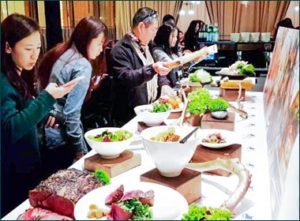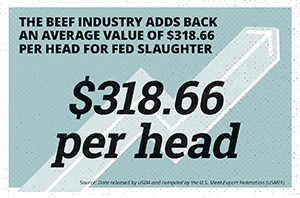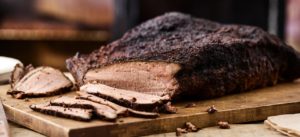 Investing dollars toward foreign market development is one of the most significant ways the Beef Checkoff drives demand for beef. Competition is fierce on the global stage, and the checkoff works diligently to persuade foreign countries that U.S. beef is their best choice. As a result of the checkoff’s efforts, more consumers around the world want the high-quality products U.S. cattlemen and women produce.
Investing dollars toward foreign market development is one of the most significant ways the Beef Checkoff drives demand for beef. Competition is fierce on the global stage, and the checkoff works diligently to persuade foreign countries that U.S. beef is their best choice. As a result of the checkoff’s efforts, more consumers around the world want the high-quality products U.S. cattlemen and women produce.
That’s why beef producers understand the importance of using checkoff dollars to promote U.S. beef in foreign countries. The U.S. Meat Export Federation (USMEF) is a subcontractor to the Beef Checkoff that carries out this mission. From attending international food events and conducting training sessions to working with retailers and encouraging restaurants to feature U.S. beef, the USMEF’s hands-on efforts put U.S. beef on more dinner plates around the world.
Korea has now become one of the leading U.S. beef markets in the Pacific, less than a decade following street protests opposing the reopening of the market. In 2018, beef exports to Korea increased 30 percent year-over-year in volume and jumped 43 percent in value, increasing from $526 million in 2017 to $1.75 billion in 20181. A big factor contributing to this gain was Costco officially converting its imported chilled beef selection from Australian to 100-percent-U.S. beef. This multi-year effort by USMEF to persuade Costco store managers to carry U.S. beef has resulted in a wider selection of U.S. beef cuts available to consumers.
 To continue increasing the visibility of U.S. beef, USMEF has established the Diamond Plus Precious Gourmet Selection awards. These awards encourage Taiwanese restaurants to serve and promote U.S. beef. According to Davis Wu, USMEF director in Taiwan, Diamond Plus Precious honors restaurants that demonstrate “the spirit of dependable and faithful partners who support U.S. beef products and promise to provide high-quality U.S. beef cuisine to Taiwanese consumers.” The USMEF first presented these awards in 2018 and will continue to honor deserving restaurants – choosing 20 each year. By creating an incentive for Taiwanese restaurants to feature high-quality U.S. beef, the Diamond Plus Precious awards are helping U.S. beef establish a stronger foothold in that country, while also providing consumers clear and accessible ways to learn about the best restaurants offering these products.
To continue increasing the visibility of U.S. beef, USMEF has established the Diamond Plus Precious Gourmet Selection awards. These awards encourage Taiwanese restaurants to serve and promote U.S. beef. According to Davis Wu, USMEF director in Taiwan, Diamond Plus Precious honors restaurants that demonstrate “the spirit of dependable and faithful partners who support U.S. beef products and promise to provide high-quality U.S. beef cuisine to Taiwanese consumers.” The USMEF first presented these awards in 2018 and will continue to honor deserving restaurants – choosing 20 each year. By creating an incentive for Taiwanese restaurants to feature high-quality U.S. beef, the Diamond Plus Precious awards are helping U.S. beef establish a stronger foothold in that country, while also providing consumers clear and accessible ways to learn about the best restaurants offering these products.
 In Japan, USMEF has been conducting a series of training sessions for cooking instructors. The goal is to show these educators the variety of ways to cook and serve U.S. beef, so they can then introduce these creative methods to their students. Rika Yukimasa, a well-known cooking instructor in Japan, has helped USMEF in the campaign, providing cooking tips and sharing information about U.S. beef’s quality attributes with fellow instructors. Tapping into U.S. beef’s superior quality and versatility is an impactful way to spur interest in the product. One training session, during which the USMEF explained the U.S. beef production system, drew thousands of participant applications of which 50 were selected.
In Japan, USMEF has been conducting a series of training sessions for cooking instructors. The goal is to show these educators the variety of ways to cook and serve U.S. beef, so they can then introduce these creative methods to their students. Rika Yukimasa, a well-known cooking instructor in Japan, has helped USMEF in the campaign, providing cooking tips and sharing information about U.S. beef’s quality attributes with fellow instructors. Tapping into U.S. beef’s superior quality and versatility is an impactful way to spur interest in the product. One training session, during which the USMEF explained the U.S. beef production system, drew thousands of participant applications of which 50 were selected.
When it comes to directly connecting with the Japanese consumer, USMEF’s Tokyo office has launched a social media campaign to promote U.S. beef while also encouraging consumer participation. USMEF’s Instagram, a photo-based social media platform, has been calling on consumers to share their experiences with U.S. beef at home and at restaurants. Individuals who share photos of U.S. beef “pound steak” are eligible for prizes. The pound steak campaign was followed by a “My Pound Steak” Instagram event to further encourage photo sharing of this great product. This social media effort is bringing U.S. beef to a platform where consumers are most active.
 “The number of active Instagram users now exceeds 29 million in Japan – up 150% from a year ago,” said Takemichi Yamashoji, USMEF director in Japan. “Realizing the popularity of social media and how consumers are using it to make decisions on what to eat, USMEF will keep focusing on these kinds of activities to more widely and effectively convey information on U.S. beef.”
“The number of active Instagram users now exceeds 29 million in Japan – up 150% from a year ago,” said Takemichi Yamashoji, USMEF director in Japan. “Realizing the popularity of social media and how consumers are using it to make decisions on what to eat, USMEF will keep focusing on these kinds of activities to more widely and effectively convey information on U.S. beef.”
The superior quality of U.S. beef has no bounds. The checkoff’s goal has always been to drive demand for beef. With programs like these in place, the checkoff is introducing high-quality beef to consumers who may never have enjoyed it before but will now continue to request it from their grocers and restaurants. Visibility is key, and U.S. beef producers recognize that investing dollars in these efforts is necessary to maintain and drive demand, so prices can remain strong even during more challenging times.


 In fiscal year 2018, the Beef Checkoff program invested checkoff funds of $7.36 million in foreign marketing and education because exports represent a significant growth opportunity for U.S. beef producers. By selling U.S. beef in more than 80 countries worldwide, the beef industry adds back an average value of $318.66 per head for fed slaughter to U.S. beef producers, according to data released by United States Department of Agriculture (USDA) and compiled by the U.S. Meat Export Federation (USMEF). USDA research also showed, from January through August 2018, beef export value climbed 18 percent from a year ago to $5.51 billion.
In fiscal year 2018, the Beef Checkoff program invested checkoff funds of $7.36 million in foreign marketing and education because exports represent a significant growth opportunity for U.S. beef producers. By selling U.S. beef in more than 80 countries worldwide, the beef industry adds back an average value of $318.66 per head for fed slaughter to U.S. beef producers, according to data released by United States Department of Agriculture (USDA) and compiled by the U.S. Meat Export Federation (USMEF). USDA research also showed, from January through August 2018, beef export value climbed 18 percent from a year ago to $5.51 billion.






 “This venue definitely attracts USMEF’s target audience – consumers with a high level of purchasing power who arrive not only from across Ukraine but also from Uzbekistan, Azerbaijan, Belarus, and other countries for vacations and long weekends,” said Galina Kochubeeva, USMEF representative in the region. “The goal for USMEF is to introduce the taste of U.S. beef to the people who attend American Barbecue Fest or visit the Wellness Center with the expectation that they will return home and begin purchasing U.S. beef on their own for family dinners and special occasions.”
“This venue definitely attracts USMEF’s target audience – consumers with a high level of purchasing power who arrive not only from across Ukraine but also from Uzbekistan, Azerbaijan, Belarus, and other countries for vacations and long weekends,” said Galina Kochubeeva, USMEF representative in the region. “The goal for USMEF is to introduce the taste of U.S. beef to the people who attend American Barbecue Fest or visit the Wellness Center with the expectation that they will return home and begin purchasing U.S. beef on their own for family dinners and special occasions.”
 Introducing U.S. beef in a country where it is not well-known, the U.S. Meat Export Federation (USMEF), sub-contractor to the beef checkoff, partnered with the USDA Foreign Agricultural Service (FAS) at the Taste Ambassadors exhibition, an event for HRI professionals in Bucharest, Romania. USMEF joined other agricultural organizations in showcasing U.S. products, presenting new culinary ideas and meeting with Romania’s HRI distributors and their clients.
Introducing U.S. beef in a country where it is not well-known, the U.S. Meat Export Federation (USMEF), sub-contractor to the beef checkoff, partnered with the USDA Foreign Agricultural Service (FAS) at the Taste Ambassadors exhibition, an event for HRI professionals in Bucharest, Romania. USMEF joined other agricultural organizations in showcasing U.S. products, presenting new culinary ideas and meeting with Romania’s HRI distributors and their clients. “The goal of USMEF in this kind of market is to educate the HRI audience about U.S. beef, ensure that buyers and traders are aware of the supply of U.S. beef that is available and to introduce beef alternative cuts,” said Barutkin. “In Romania, as is the case with many countries in eastern and central Europe where disposable incomes are rather tight, alternative cuts of U.S. beef present good opportunities for some budget-conscious consumers and allow many more restaurants to feature U.S. marbled beef on their menus.”
“The goal of USMEF in this kind of market is to educate the HRI audience about U.S. beef, ensure that buyers and traders are aware of the supply of U.S. beef that is available and to introduce beef alternative cuts,” said Barutkin. “In Romania, as is the case with many countries in eastern and central Europe where disposable incomes are rather tight, alternative cuts of U.S. beef present good opportunities for some budget-conscious consumers and allow many more restaurants to feature U.S. marbled beef on their menus.”